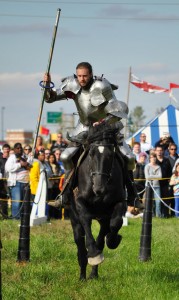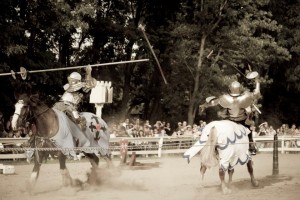
When most people think about extreme sports, activities like bungee jumping and rock climbing are usually on the list. But according to Georgia State student Matt Hiltman, a senior and philosophy major, there is one sport that tops most people’s idea of extreme.
“There isn’t a baseball swing out there that can knock a man in armor off his horse. Not even budge him. The hardest baseball swing wouldn’t even budge someone on horseback.”
The name of this extreme sport is jousting. It’s an unfamiliar sport to many people in the Southern region, but Hiltman is an exception, and a highly-experienced one at that.

Jousting is Matt Hiltman’s favorite hobby and once worked at Medieval Times for five years doing the competitive sport.
According to history.com, jousting can be traced back centuries ago to the medieval era in which men from all levels of the social ladder were extensively and often dangerously taught how to defend their king should a war erupt. Considered by most historians to be the first-known extreme sport, it slowly dwindled into a form of entertainment until its popularity shrunk as safer forms of extreme sports took its place.
“And actually I think the style we do [today]…[is] more difficult than what they did in the medieval ages,” Hiltman said. “…I’ve heard that they used lances [swords] that were not entirely solid…and we used thick lances…they weigh about 20 pounds and they’re 11 feet long.”
Although its popularity in modern times is nothing compared to its first few decades of existence, jousters like Hiltman view it as competitively as other athletes view more popular sports like basketball.
Hiltman is so competitive in jousting, he auditioned for History Channel’s Full Metal Jousting earlier this year and became one of 16 contestants. He made it to the final two before losing to contestant Joshua Knowels.
“I didn’t win the prize but I got second place so I did pretty well,” he said. “And since the TV show finished airing in the spring, after that I was able to do some gigs.”
After the end of the show’s first season, Hiltman and other contestants are occasionally invited by host Shane Adams, who has his own full-time jouster troop, to participate in renaissance festivals where the demand for jousters is most high.
“So what happens is, I go out there, I don’t have my own horse or armor, but in the troop they’ve got a set of armor for whoever needs it,” Hiltman said. Since Adams provides the men with armor and horses, it’s usually never a big deal for him to travel to the festivals. “So I go out there, I do my thing, and come back.”
Despite the casual manner in which Hiltman explains his love for jousting, the details of how it unfolds between two competitors may seem too intense for even the most skilled athlete.

This is a contact sport with blows that feel like a car crash, according to jouster Matt Hiltman.
Although the men have on armor, Hiltman explains that the goal of this particular German-style of jousting used in the show is to strike the opponent in what’s called a gridded guard grand. This plate can be found underneath the jouster’s armor to catch the opponent’s lance.
“It’s the most brutal type [of jousting] because all that force is transferred directly to that jouster,” he said. It’s during what Hiltman calls ‘passes,’ that each competitor attempts to strike. “And how accurate you are is determined by whether you strike the right spot, that gridded grand guard.”
According to Hiltman, competitors don’t receive any points unless they superficially strike the opponent’s gridded grand guard. Whether he’s competing or doing it for entertainment purposes, Hiltman enjoys the adrenaline rush.
“It’s pretty awesome. I mean, another aspect of jousting is you’ve got no defense. There’s nothing you can do to protect yourself. The armor protects you as best it can,” he said. “I’ll tell you what, here’s the best way of describing it: if you’ve ever gotten into a 40 mile an hour car crash, that’s exactly what it feels like. I’ve done both and they’re very comparable.”
Even Hiltman’s family and friends support and encourage his favorite sport.
“My parents knew that if they didn’t let me have creative, exciting ways to channel my energy that it might not turn out so good, so they encourage that kind of stuff.”
Growing up, Hiltman said he’s always been somewhat of a risk-taker. He was a boy scout and in his later years as a young adult, he enjoyed scuba-diving and power gliding. After graduating high school, Hiltman landed a job at Atlanta’s Medieval Times, a dinner attraction with a theme centered on that specific era. Jousting is used as a form of entertainment for customers.
“I didn’t know how to ride, didn’t know how to joust, how to sword fight, didn’t know how to act,” he said. “But I was trained for two months down in Florida and taught how to ride horses, and [I] was taught how to [choreograph] jousting that they do for the dinner theatre show.”

Midway through his almost five-year position at Medieval Times, Hiltman enrolled at Georgia State University and eventually quit his job.
Six months after quitting, he heard about a casting call for the show “Full Metal Jousting,” and the rest is history.
As risky as the sport sounds, Hiltman doesn’t fear anything, including his own safety. He said he’s never had any broken bones, stitches, nasty scars or anything else at this point in his jousting experience, although he did receive a minor leg injury during the taping of “Full Metal Jousting.” Even still, he insists that other sports cause more harm than jousting.
“I did Rugby here at GSU for a semester and I got injured more in a few practices than [I’ve] ever been injured at Medieval Times,” he said. “I think people who play rugby are nutty.”
